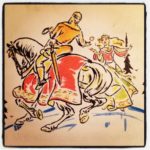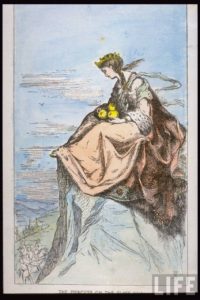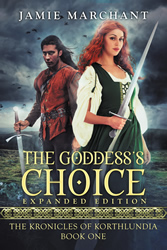Where did the Goddess Come from?
The expanded edition of The Goddess’s Choice will be released on June 15. To celebrate, let me tell you how it all began.
The Goddess’s Choice, expanded edition
Origin Story
 The Goddess’s Choice comes from deep within my childhood. My sister Jalane–she is ten years older than me–would tell me and my younger sister stories, fairy tales mostly: “Midas and His Golden Touch,” “The Three Little Men in the Forest,” “Hanzel and Gretel.” But my favorite was always “The Princess and the Glass Hill” or “The Glass Mountain” as my sister titled it. Wendie and I would have her tell that story over and over again. I was captivated by the bold hero on his magical horses of bronze, silver, and gold toiling up a mountain made of glass to win the princess’s hand.
The Goddess’s Choice comes from deep within my childhood. My sister Jalane–she is ten years older than me–would tell me and my younger sister stories, fairy tales mostly: “Midas and His Golden Touch,” “The Three Little Men in the Forest,” “Hanzel and Gretel.” But my favorite was always “The Princess and the Glass Hill” or “The Glass Mountain” as my sister titled it. Wendie and I would have her tell that story over and over again. I was captivated by the bold hero on his magical horses of bronze, silver, and gold toiling up a mountain made of glass to win the princess’s hand.
 As I got older, the story faded from my consciousness. For years I hardly thought about it. Then in graduate school it came back to me in an essay I wrote. We were discussing children’s literature in a Women’s Studies course and had to do a personal essay on our experience with literature as a child. The story of “The Princess and the Glass Hill” figured heavily in that paper. That’s when the inherit sexism of the story was brought forcibly home. The princess has no name, no personality, performs almost no actions. She is not even described. She is nothing more than the prize–a trophy–to be handed off to the lucky man who wins her father’s contest. How she feels about the matter is not discussed, not even thought of, as I did not think about it when I was a child. I identified with the bold young hero of the tale, not the nearly invisible princess waiting at the top of the mountain with her golden apples.
As I got older, the story faded from my consciousness. For years I hardly thought about it. Then in graduate school it came back to me in an essay I wrote. We were discussing children’s literature in a Women’s Studies course and had to do a personal essay on our experience with literature as a child. The story of “The Princess and the Glass Hill” figured heavily in that paper. That’s when the inherit sexism of the story was brought forcibly home. The princess has no name, no personality, performs almost no actions. She is not even described. She is nothing more than the prize–a trophy–to be handed off to the lucky man who wins her father’s contest. How she feels about the matter is not discussed, not even thought of, as I did not think about it when I was a child. I identified with the bold young hero of the tale, not the nearly invisible princess waiting at the top of the mountain with her golden apples.
After graduate school, “The Glass Mountain” made another appearance when I had a child of my own. I loved the story so much as a child, I wanted to pass it on to my son. Jesse loved it every bit as much as I had.
 But one day after telling it to him, it came to me that the story could be so much more than the few pages and sparse details devoted to it in either the original or my sister’s version. Robbie (in my sister’s version, he was merely the youngest brother) was born sleeping in the attic on a straw mattress. Although that detail didn’t survive into the final version, it was the gem of the story. I also knew that my princess would be no passive character in the tale of another. The princess would be as strong and full developed as Robbie–a true heroine to match his hero. Samantha came to be, dreading yet another ball. She would far rather be riding her horse.
But one day after telling it to him, it came to me that the story could be so much more than the few pages and sparse details devoted to it in either the original or my sister’s version. Robbie (in my sister’s version, he was merely the youngest brother) was born sleeping in the attic on a straw mattress. Although that detail didn’t survive into the final version, it was the gem of the story. I also knew that my princess would be no passive character in the tale of another. The princess would be as strong and full developed as Robbie–a true heroine to match his hero. Samantha came to be, dreading yet another ball. She would far rather be riding her horse.
You can read the original fairy tale at The Princess and the Glass Hill. Jalane took a lot of license in telling her tales, so her version was more exciting than this one. Also, although the novel originated from a fairy tale, it is not a children’s story. It is definitely intended for adults.
